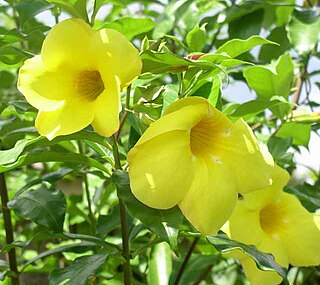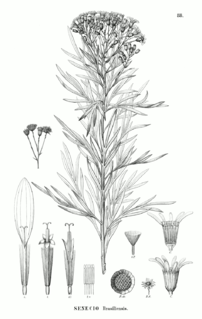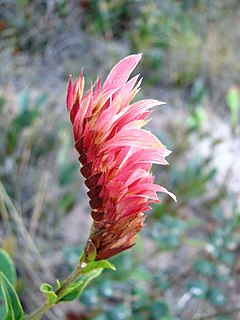
Allamanda cathartica, commonly called golden trumpet, common trumpetvine, and yellow allamanda, is a species of flowering plant of the genus Allamanda in the family Apocynaceae. It is native to Brazil. This plant is cited in Flora Brasiliensis by Carl Friedrich Philipp von Martius.

Ficus elastica, the rubber fig, rubber bush, rubber tree, rubber plant, or Indian rubber bush, Indian rubber tree, is a species of plant in the fig genus, native to eastern parts of South Asia and southeast Asia. It has become naturalized in Sri Lanka, the West Indies, and the US State of Florida.

August Wilhelm Eichler, also known under his Latinized name, Augustus Guilielmus Eichler, was a German botanist who developed a new system of classification of plants to reflect the concept of evolution. His author abbreviation in botany is Eichler.

Flora Brasiliensis is a book published between 1840 and 1906 by the editors Carl Friedrich Philipp von Martius, August Wilhelm Eichler, Ignatz Urban and many others. It contains taxonomic treatments of 22,767 species, mostly Brazilian angiosperms.

Anchusa barrelieri, Barrelier's bugloss or false alkanet, is a species of plant in the Boraginaceae plant family. It is sometimes used as an ornamental plant.
Ruellia verbasciformis is a plant native to the Cerrado vegetation of Brazil. This plant is cited in Flora Brasiliensis by Carl Friedrich Philipp von Martius.
Hygrophila costata, with the common names glush weed, gulf swampweed, and yerba de hicotea, is an aquatic plant

Lophostachys floribunda is a plant native to the Caatinga and Cerrado vegetation of Brazil. This plant is cited in Flora Brasiliensis by Carl Friedrich Philipp von Martius.
Lophostachys falcata is a plant native to the Cerrado vegetation of Brazil. This plant is cited in Flora Brasiliensis by Carl Friedrich Philipp von Martius.
Lophostachys montana is a plant native to the Cerrado vegetation of Brazil. This plant is cited in Flora Brasiliensis by Carl Friedrich Philipp von Martius. The Latin specific epithet montana refers to mountains or coming from mountains.
Lophostachys sessiliflora is a plant native to the Cerrado vegetation of Brazil. This plant is cited in Flora Brasiliensis by Carl Friedrich Philipp von Martius.
Lophostachys villosa is a plant native to the Cerrado vegetation of Brazil. This plant is cited in Flora Brasiliensis by Carl Friedrich Philipp von Martius.
Stenandrium pohlii, with Portuguese common names caiapiá or carapiá, is a plant native to Cerrado and Pantanal vegetation of Brazil. The description of the plant was published in Flora Brasiliensis in 1847.
Lophostachys is a genus of plants in the family Acanthaceae.

Anemopaegma glaucum is a plant native to Caatinga and Cerrado vegetation in Brazil. This plant is cited in Flora Brasiliensis by Carl Friedrich Philipp von Martius.

Parietaria is a genus of flowering plants in the family Urticaceae, native to temperate and tropical regions across the world.

Arundinella is a widespread genus of plants in the grass family, common in many tropical and subtropical regions.
Dillwynia laxiflora is a shrub species in the pea family. It is endemic to the south west of Western Australia, where it usually occurs in sandy or gravelly soils on hillcrests. It is spreading shrub to 1.25 metres high with yellow and red flowers.
Bursera laxiflora is a North American species of trees in the frankincense family in the soapwood order, native to northwestern Mexico. It is fairly common in Sonora with additional populations in Sinaloa, Baja California Sur, and Socorro Island. There is a report of the species being found in the United States, but it is from the property of the Arizona-Sonora Desert Museum west of Tucson, most likely a cultivated or escaped specimen.
This page is based on this
Wikipedia article Text is available under the
CC BY-SA 4.0 license; additional terms may apply.
Images, videos and audio are available under their respective licenses.








